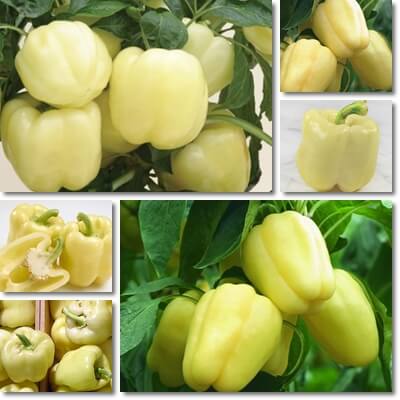Also known as white Holland peppers, white bell peppers are essentially a cultivated variety of sweet pepper.
Their distinguishing feature is their pale yellow or pale green skin that looks almost white from afar, hence their name.
The cultivar has a pleasant, mildly sweet taste with faint bitter flavors and is great to eat both raw and cooked.
As a less colored sweet pepper cultivar, the white bell pepper provides nutrition similar to its more colorful relatives, namely vitamin C, vitamin A from antioxidant carotenoids, vitamins B1 through B9, vitamin K, vitamin E, choline, calcium, copper, iron, magnesium, manganese, phosphorus, potassium and zinc, but no sodium. Consumption holds benefits for the digestive system, weight loss and a number of other benefits associated with its essential vitamin, mineral and antioxidant content.

White bell peppers vs white Holland bell peppers
Both names can be and are used interchangeably to denominate a sweet bell pepper cultivar with a pale skin of a yellow or greenish color.
The choice for one name over another, or variations of these names, are purely personal choices as the nomenclature is not currently officially established.
Some people will call all bell peppers Holland peppers, irrespective of color, which would mean there are white, yellow, orange, red, green, purple and even striped Holland peppers.
Some people will also use the term ‘bell’ in the name to better identify the cultivar, resulting in names such as red or white Holland bell peppers.
Others will only refer to bell peppers grown in Holland as Holland bell peppers, and seeds and seedlings coming from there (apparently, the skin is also thicker and the taste superior, but this has more to do with growing conditions if you ask me). Some people will only call white bell peppers with particularly pale skin white Holland bell peppers.
There are also those who will refer only to pale-colored bell peppers grown in hothouses or heated greenhouses as white Holland, whether they’re really from Holland or the US, China or somewhere else.
This is because the pale color is attributed to the lack of direct sunlight exposure which is presumed to prevent pigment from forming in the fruits. Anyway, the most important piece of information you can take with you from this is that these names all refer to the same pepper.
What do white bell peppers look like?
They look like a typical bell pepper: medium to large size, plump and hollow inside, with either 3 or 4 lobes at the base (the end opposite to the stem) and a smooth, uniform-colored, pale yellow or pale green skin. Typically, the less ripe fruits are slightly more greener, while the riper ones are more yellow, but still pale. The flesh inside is the same color as the skin and is, in ideal conditions, thick and crisp. Inside, towards the stem, there is a white, spongy pulp to which dozens of round, flat, creamy white seeds are attached.
What do white bell peppers taste like?
Depending on the age of the fruit at harvest time and also other factors, notably growing conditions such as soil quality, amount of rainfall, temperature and amount of sunlight received during the maturation process, the taste and flavor profile of white Holland bell peppers may be slightly different from one fruit to another.
But white is just one of the different colors of the cultivar and white bell peppers taste a lot like other colors: mildly sweet, with faint bitter flavors, but no heat, and a strong, fresh peppery smell. Ideally, the flesh is tender, crisp and pleasant, suitable for eating raw and cooked.
To compare with other colors, white bells taste a lot less bitter than green ones, but less sweet than red. At the same time, I find they have a stronger taste and flavor profile than yellow and orange ones.

Where to find white bell peppers and how to grow them
You can find fresh white bell peppers at the supermarket, in the fresh produce section, at farmer’s markets, or you can grow them yourself if you have a few feet of garden space. You can easily find white bell pepper seeds for sale online or even at your local supermarket in spring or fall, or get seedlings from nurseries in your area.
To make sure your plants thrive, till the earth and add topsoil for vegetable gardens, then water regularly. The plants will produce fruits generously as soon as the temperatures rise, so don’t plant too early (safest time to transfer seedlings outside is mid-April in the Northern hemisphere).
You may find white sweet bell pepper seeds are somewhat fickle and can sometimes take up to a few weeks to germinate, even indoors, depending on temperature and amount of sunlight they receive. Whether you plant from seed or get seedlings, bell pepper plants in general are fairly easy to maintain once established and require overall little effort (basically heat and sunlight and only regular watering from your part).
Uses and recipe ideas Of White Bell Peppers
One of my favorite ways to eat white bell peppers is raw: slice in wider strips and use to scoop up cream cheese, chickpea or white bean humus, avocado or another dip of your choice. I also like to eat them with soft and hard cheeses, such as Camembert, Brie, feta cheese or ‘telemea’.
I absolutely love them stuffed with rice or meat or fried in sunflower oil in a plain risotto. But there are so many things you can do with them, from adding to fresh salads (Mediterranean style tomato, cucumber, onion, parsley salad) to roasting, grilling and pickling (pickled white bell peppers are an interesting, but delicious recipe to consider if you love pickles).
Nutrition facts Of White Bell Peppers
White sweet peppers nutrition is inferred from the nutrition of other sweet peppers.
That is to say, exact amounts of micro and macro-nutrients have not yet been determined for this particular color variant. But the variety is presumed to contain most, if not all of the essential vitamins and minerals of other colors, and about the same amounts of carbohydrates, sugar, dietary fiber, fat and protein and the same energetic value.
As such, white bell peppers contain vitamin C (exact vitamin C content is undetermined, but presumed good), vitamins B1, B2, B3, B5, B6 and B9 in limited amounts (roughly less than 5% of the recommended daily intake for an average adult), trace amounts of vitamin E (concentrated in the seeds), vitamin K (content undetermined, but presumed lower than in green bells), choline, calcium, copper, iron, magnesium, manganese, phosphorus, potassium and zinc.
Like other colors, white bell peppers have no detectable or nutritionally significant levels of sodium. Energetic value is estimated at about 20 kilocalories (calories) per 100 grams of fruit, carbohydrate content at 4-5 grams, of which sugars 2-2.5 grams, dietary fiber content at around 2 grams, protein content below 1 gram and fat content below 0.2 grams.
Although a less impressive source of pigmented antioxidants compared to other colors, it does contain flavonoids and other polyphenols. Unlike other colors such as red which contains carotenoids, green which is rich in chlorophyll or purple and black which are sources of anthocyanins.
Also see the benefits of black bell peppers.
Also see the benefits of purple bell peppers.
Also see the benefits of red bell peppers.
Also see the benefits of orange bell peppers.
Also see the benefits of yellow bell peppers.
Also see the benefits of green bell peppers.
Benefits of white bell peppers
- Good food to eat for weight loss (low in calories, fat and carbohydrates).
- Benefits for the digestive system: relieving constipation thanks to a good fiber content.
- Source of antioxidants with free radical-scavenging properties – studies show antioxidants help counteract and prevent cell damage resulting in chronic disease.
- Anti-inflammatory properties from vitamin C and other antioxidants, flavonoids and polyphenols.
- Minor benefits for cholesterol levels: contributes to better cholesterol numbers thank to a good dietary fiber content and low calorie, fat and carbohydrate content promoting healthy weight loss.
- Minor benefits for blood pressure: thanks to a modest potassium and magnesium content and no sodium, it promotes lowering of high blood pressure numbers.
- Good food to eat for anemia: while definitely not as good as meat, fish, eggs, milk, dairy or other plant foods, it does contain small amounts of iron, vitamins B6 and B9 for heme synthesis and red blood cell production and vitamin C for increasing iron absorption.
- Minor benefits for the immune system thanks to vitamin C which enhances the immune system function and exerts an anti-inflammatory and free radical-scavenging function.
- Minor benefits for skin health: B vitamins help prevent skin inflammation and reduce infection risks, vitamin C boosts collagen production for skin elasticity, vitamins C and E promote wound healing and exert antioxidant and anti-aging properties.
Potential for side effects
Possible side effects may include: potential for allergic reactions (although a less common allergen compared to eggs, milk or soy), indigestion and digestive upset, especially in acid reflux disease (GERD) and gastritis.
Symptoms of an upset stomach may include bloating, burps that smell like pepper, stomach pain, especially pain in upper right abdomen, belly button pain or pain in the center of the abdomen or chest, cramps, gas, nausea and heartburn. Symptoms may last anywhere from a couple of hours to a couple of days, depending on intake. Side effects signaling intolerance may include loose stools and diarrhea.
